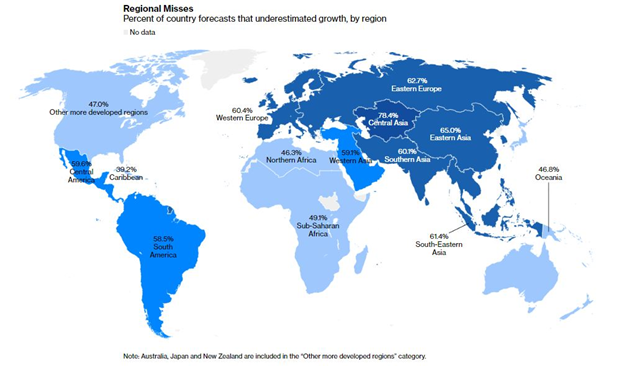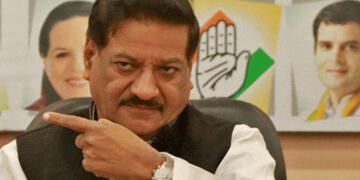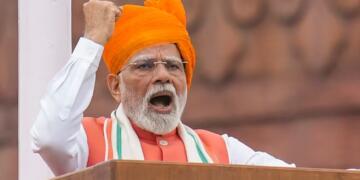On Thursday, the International Monetary Fund (IMF) spokesman Gerry Rice told reporters that India’s economic growth is “much weaker” than expected. The global lender cut India’s growth projection by 0.3 percentage point to 7 percent for the FY 19-20. The IMF has however said that India will still be the fastest growing major economy in the world.
“We will have a fresh set of numbers coming up, but the recent economic growth in India is much weaker than expected, mainly due to corporate and environmental regulatory uncertainty and lingering weakness in some NBFCs,” said Rice.
Earlier in April, the IMF had cut the growth forecast for India by 20 basis points for the fiscal 2019-20. It had also lowered the growth projection by 20 basis points for 2019. In 2017, the IMF had slashed India’s growth forecast to 6.7 after projecting India’s GDP growth at 7.2 percent in the month of April.
According to the World Economic Outlook (WEO) released during 2019 Spring Meeting, India was expected to grow at 7.3 per cent in fiscal year 2019-20. This was 20 basis points lower than January outlook and 10 basis points lower than October’s forecast.
This is not the first time IMF has ‘revised’ its growth projections. Not just India, the agency does the same thing with every country in every quarter. On an interval of few months, you will find reports in newspapers about IMF ‘slashed/increased’ growth forecast of Indian economy or that of global economy.
This phenomenon is not limited to IMF, the global institutions like World Bank, United Nations which claim to have best ‘analyst’ in their organizations, get more than half of their projections about different socio-economic indicators wrong.
Almost two years ago, Rathin Roy, member of the Economic Advisory Council to the Prime Minister (PMEAC) had slammed these institutions. Roy had said, “IMF’s growth projections are 80% wrong…World Bank’s growth projections are 65% wrong.”
Financial Times, the British newspaper, which is considered an essential read for policy makers, economists, and bureaucrats published an article titled ‘IMF shows poor track record at forecasting recessions’ on April 9, 2018.
As per the article, “Over the last 27 years, the IMF has predicted every October that an average of five economies will contract the following year. In practice, an average of 26 have contracted.”

Another article published in Bloomberg, the company which has the largest depository of financial data, argued the same. The article titled ‘Economic Forecasting Is Really Difficult. Just Ask the IMF’ was published in April 2019. As per this article, “In 6.1 percent of cases, the IMF was within a 0.1 percentage-point margin of error. The rest of the time, its forecasts underestimated GDP growth in 56 percent of cases and overestimated it in 44 percent.”

The institution publishes global growth projections in its World Economic Outlook two times every year- In April and October. In addition to that, its regional branches publish country specific and region specific growth projections every quarter.
The business of claiming expertise in the field despite getting projections wrong every time is not limited to IMF and World Bank, institutions like United Nations are also in the business.
Sanjeev Sanyal, current Principal Economic Advisor had earlier questioned the UN population growth projections, but the institution wrote a curt letter to him instead of looking into the matter. A few months ago, the UN had ‘revised’ global population growth projections. “UN slashes forecast of peak world population by 300mn to 10.9 in 2100. I had been arguing for years that their forecasts are just too high & still expect further reductions. Fertility rates are dropping sharply everywhere. When I began questioning UN forecasts some years ago, the then head of the Pop Division had written a curt letter to me, & was even more rude when I pointed out that UN’s fertility assumptions are incompatible with their own forecast of urbanization & female literacy,” tweeted Sanyal after UN revised the projections.
UN slashes forecast of peak world population by 300mn to 10.9 in 2100. I had been arguing for years that their forecasts are just too high & still expect further reductions. Fertility rates are dropping sharply everywhere 1/nhttps://t.co/iwYZi2n87a
— Sanjeev Sanyal (@sanjeevsanyal) June 24, 2019
The problem does not lie in making wrong projections. The global economy is and always has been volatile and therefore no institution or individual could make cent percent correct projections. But the organization must recognize its mistakes, take due cognizance if someone points out discrepancies, and stop claiming to be an expert on the subject.


































